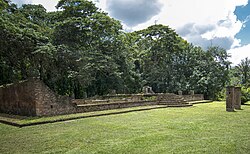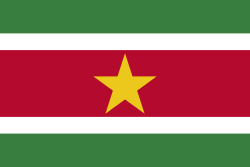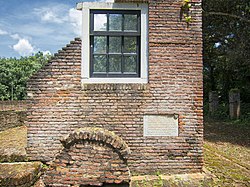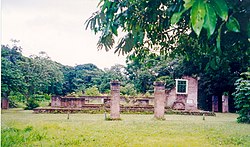20191129 Suriname 0175 Jodensavanne sRGB (49295607902)
Some of the tombstones in the Portuguese-Jewish cemetery Beth Haim (House of the Living). They are placed lying down in accordance with Sephardic tradition. Most of the gravestones were imported from Amsterdam. Less-wealthy Jews would have had to settle for wooden grave markers. The graves in the cemetery date from 1685 to 1873.
Jodensavanne (Jewish Savanna) was a settlement established by Jews in the 17th century on the right bank of the Suriname River at Cassipora Creek. The 1639 decision by the English government to permit Sephardic [Spanish/Portuguese] Jews to settle in Suriname prompted the first wave of Jews to the area who fled the Inquistion and came to Torarica, Suriname’s first capital. In 1652 a second wave of 1,200 Jews migrating under the leadership of Lord Francis Willoughby, Governor of Barbados, arrived and settled around Cassipora Creek. A third wave of Jews from French Guiana (previously expelled from Brazil in 1654) joined them in 1664. To boost the Suriname economy by attracting more planters, the Jewish community was granted freedom of religion in 1665, a right retained when the Dutch acquired Suriname in 1667. In 1669 the Jews received official permission to form a community with a synagogue and cemetery protected by a Jewish militia—creating the only Jewish diaspora group with political and religious autonomy prior to Israel’s founding— which led to the establishment of Jodensavanne on a hill overlooking the Suriname River. A large brick synagogue named Berachah ve Shalom ('Blessing and Peace') was erected in 1685. For a brief while the Jewish plantation owners had permission to give their slaves Saturdays off instead of Sundays. By the end of the 1600’s, ‘Jerusalem by the riverside’ comprised nearly 600 Jews owning over 40 plantations and around 9,000 slaves. After years of prosperity, the area went into decline starting in the 1780’s. A massive fire in 1832 started by a slave rebellion destroyed Jodensavanne prompting its abandonment although services continued in the synagogue until 1860.
On Google Earth:
Jodensavanne 5°25'45.23"N, 54°59'4.36"WRelevantní obrázky
Relevantní články
JodensavanneJodensavanne je název archeologické lokality v Surinamu. Nachází se přibližně 50 km jižně od hlavního města Paramaribo, na břehu řeky Surinam, v distriktu Para. V roce 2023 byla lokalita společně s nedalekým hřbitovem v Cassipora Creek zapsána na seznam světového dědictví UNESCO. Bývalo jedna z prvních židovských osad v Jižní Americe. .. pokračovat ve čtení





